Submitted by Norm Roulet on Thu, 02/17/2011 - 04:27.

The field of ESTA-1 variety hemp, showing the relatively weed free ground below the plants.
Ontario's Renfrew County - the farm of John and Rae Ann Briscoe - Harvest 2006
The article included below - Energy Farming In America, by Lynn Osburn, from 1989 - really puts in perspective the evil of America's current energy portfolio and our global climate crisis, as it reports that on June 12, 1989, the first President Bush "recommended auto makers be required to make methanol-powered cars for use in nine urban areas plagued by air pollution - Bush called methanol "home-grown energy for America"."
Reporting on this, in 1989, the author of Energy Farming In America forecast "Hemp is the only biomass resource capable of making America energy independent. Remember that in 10 years, by the year 2000, America will have exhausted 80% of her petroleum reserves. Will we then go to war with the Arabs for the privilege of driving our cars; will we stripmine our land for coal and poison the air we breathe to drive our autos an additional 100 years; will we raze our forests for our energy needs?"
Yes, yes and yes.
George Bush Sr. failed to act on his 1989 promise to move America off foreign oil, and his son took us to war against the Arabs "for the privilege of driving our cars" shortly after 2000 - under President Obama, we have a Middle East in melt-down, are expanding strip-mining of coal and poisoning of the air we breathe, are clearing our forests for biomass.... and we have punched a hole in the bottom of the ocean, spilled millions of gallons of oil, and discovered FRACKING to make the world even worse... as oil prices are at historic highs and NEVER COMING DOWN AGAIN... all in corrupt addiction to fossil fuels in global self-destruction.
It sure would be nice to OWN IRAQ, wouldn't it!
For the best explanation ever of the US and British invasion of Iraq, see Welcome to BP’s Energy Outlook 2030 - "it is a wake-up call, not something any of us would like to see happening"
Iraq is an important component of future oil supply...
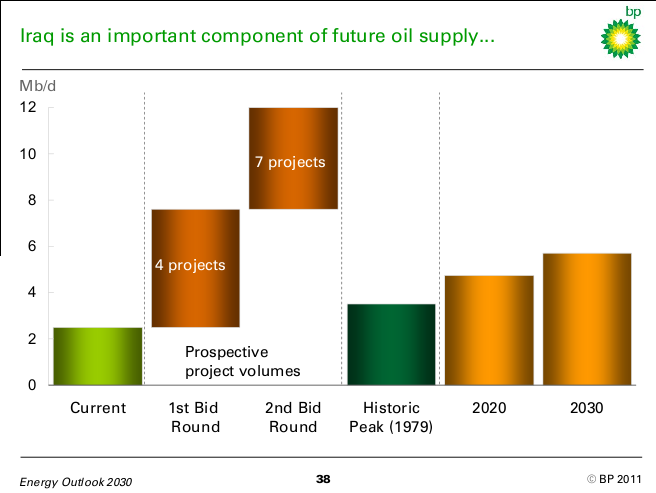
...and a major source of uncertainty
The pace of Iraqi capacity expansion – and production growth – is a key source of uncertainty for this outlook. Iraq is expected to account for 20% of global supply growth from 2010 to 2030.
Of course, we lost that war... and are losing the climate war... the environmental justice war... the energy independence war.
Is losing war in the Middle East, killing 1,000s of American soldiers and 100,000s of Arabs, ruining the planet, poisoning 100,000,000s of Americans, and remaining enslaved to dead dinosaurs REALLY easier - brighter and greener - than innovating with energy crops and doing agriculture well in America.
REALLY!
As Ms. Osborn reported, in 1989: "William Reilly, chief of the Environmental Protection Agency, at a briefing before Bush's speech, estimated the cost of the (his) plan would be between $14 billion and $19 billion a year after its full implementation at the turn of the century."
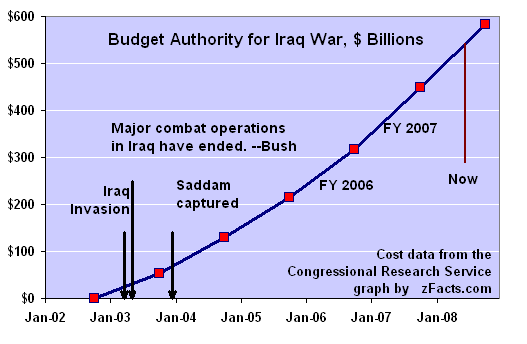
Already, we've spent more than $1 trillion in Iraq, not counting the $700 billion consumed each year by the Pentagon budget.
And spending in Iraq and Afghanistan now comes to more than $3 billion weekly
The war with Iraq and Afghanistan (which is attractive to the West because it has a massive supply of lithium, for batteries) is expected to cost between $3 and 4 TRILLION.
$3-4 TRILLION for WAR versus $20 billion a year to develop clean energy alternatives, which would create jobs, rather than kill Americans.
$200 billion spent in America from 2000-2010, building our natural resources and capacities, certainly seems a bargain today compared to paying out $4 trillion over 40 years for a failed war.
Especially considering the 100,000s who die at war... the 1,000,000s left damaged after war... and that everything we have done as a global society, since 1989, has made pollution and greenhouse gas levels significantly worse world-wide, leading to drastic consequences.
And Old Man Bush saw this coming, in 1989, and failed to react - he knew: "Too many Americans continue to breathe dirty air, and political paralysis has plagued further progress against air pollution. We've seen enough of this stalemate. It's time to clear the air."
The Republicans knew the disaster to come - and knew to do better - and betrayed the nation and world instead. The Democrats did no better.
Lynn Osburn explains this stalemate, still killing Americans since Old Man Bush failed to act on his promises... "In the late 1800s, the fledgling petroleum industry aggressively competed with the established biomass-based energy industry in a effort to gain control of world energy production and distribution. Fossil fuel producers succeeded in their campaign to dominate energy production by making fuels and chemical feedstocks at lower prices than could be produced from biomass conversion. Now the pendulum is swinging against them. It is likely that peak oil and gas production in the coterminous United States has been reached. The bulk total production of roughly 80% will be reached by the year 2000. Peak world production will occur about the same year."
Obviously, both Bush Sr. and his son were too weak of leaders - too ignorant or incompetent - to break through this stalemate, still ruining the nation and planet.
The author had a better crystal ball than all our Presidents since, and all their incompetent little pawns, as the BP Energy 2030 forecast agrees with Osborn and finds the world exceeded peak non-OPEC conventional oil supply before 2000, and exceeded world peak oil supply shortly after... and:
Supply growth comes primarily from OPEC...
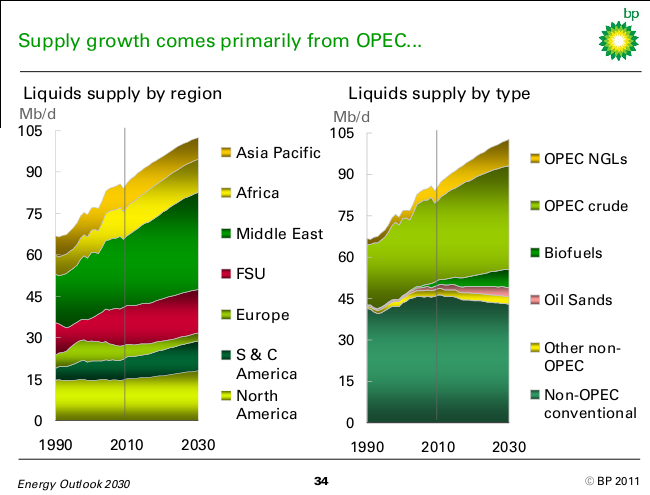
...as unconventional liquids cause modest non-OPEC growth.
That "Modest non-OPEC growth" is the small amount of "home-grown energy for America" we have actually set in motion, since 1998 ... which Bush Sr. correctly projected COULD save the world, if made a priority in 1989, and done right.
Instead, we've been doing biofuels all wrong - and there has been limited biofuels innovation in America, and what biofuel is produced is largely an eco-unfriendly product of subsidized corn diverted from food production... with poor environmental results.
So, the world must now focus on the following chart, showing disastrous greenhouse gas impacts well beyond 2030 as a result of America remaining addicted to fossil fuels since 1989, and doing biofuels wrong in the process... and this chart is optimistic...
Policies to constrain carbon emissions gradually tighten...
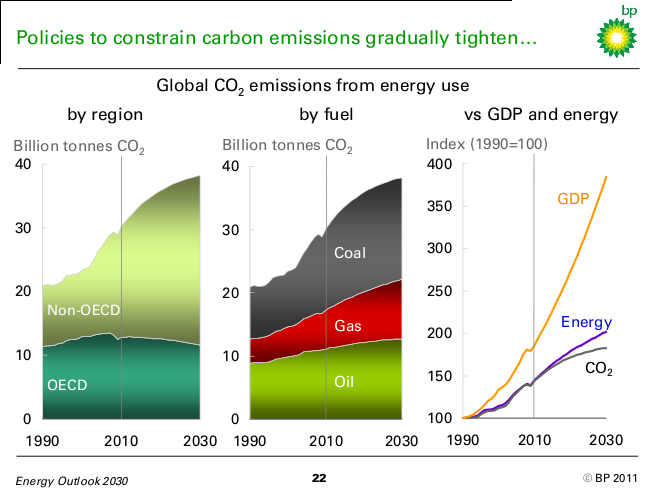
...and have a significant impact on emissions growth by 2030.
Environment-incompetent BP has come to agree with what the first environment-incompetent President Bush knew, and failed to act upon - that biofuels are essential to the survival of the planet.
Biofuels meet an increasing share of demand growth...
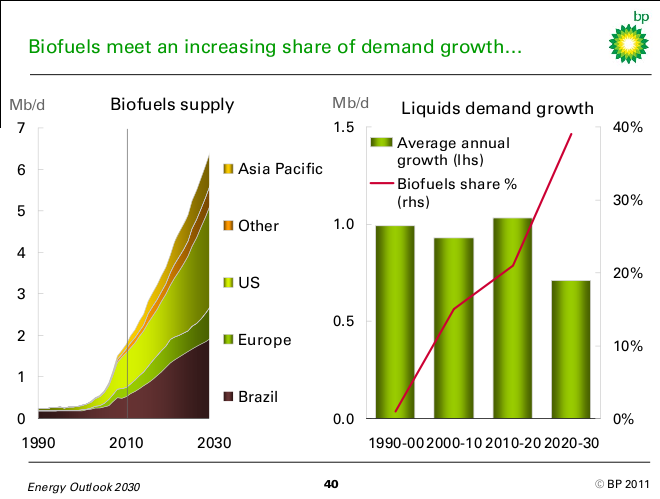
...driven by supply expansion in the Western Hemisphere
Biofuels production (largely ethanol) is expected to exceed 6.5 Mb/d by 2030, up from 1.8 Mb/d in 2010 – contributing 30% of global supply growth over the next 20 years, and all of the net growth in non-OPEC.
Continued policy support, high oil prices in recent years, and technological innovations all contribute to the rapid expansion.
The US and Brazil will continue to dominate production; together they account for 68% of total output in 2030 (from 76% in 2010). First-generation biofuels are expected to account for most of the growth.
After 2020, roughly 40% of global liquids demand growth will be met by biofuels – up from 13% in 2010 – with the US and Europe leading consumption growth. By 2030, this figure approaches 60%.
In fact, in his 2011 State of the Union Address, current US President Obama declared America must move to 80% renewable energy by 2035, meaning BP's forecast is low.
Unfortunately, Obama's actions to save the environment to date have been way too little, too late.

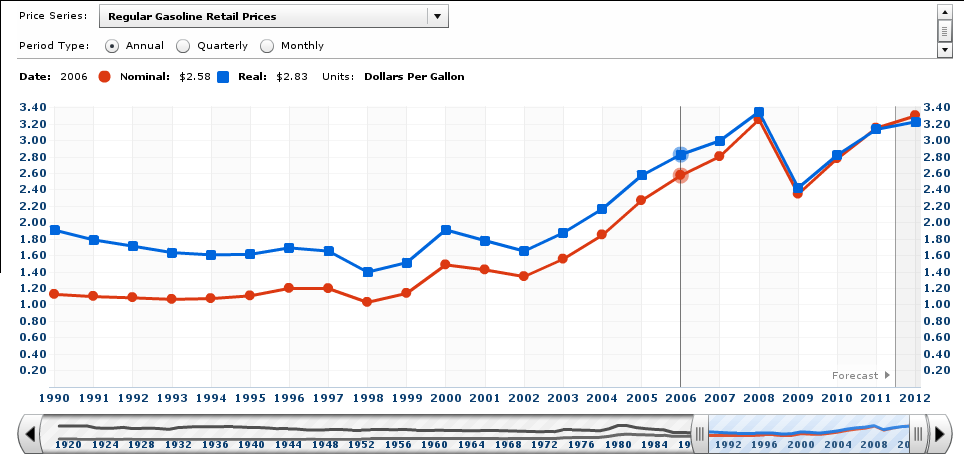
Imported crude oil prices and prices for everything made from oil are at historic high prices today, and are never really expected to go lower - they show strong signs the world is headed for rampant inflation, scarcity, and global economic disaster.
And that is not even factoring in the environmental catastrophe we are living through, today... not to mention unpredictable impacts of climate change ahead.
Like the first President Bush declared, in 1989... and Obama must ape today... "Too many Americans continue to breathe dirty air, and political paralysis has plagued further progress against air pollution. We've seen enough of this stalemate. It's time to clear the air."
What BP also doesn't put in their report, Bush may not have understood, and Obama must still acknowledge, is that corn biofuel is not the solution - hemp biofuel is.
As pointed out in Energy Farming In America, "To accomplish this goal of clean energy independence in America we must demand an end to hemp prohibition, so American farmers can grow this energy crop. Our government foolishly outlawed it in 1938. Hemp is the world's most versatile plant. It can yield 10 tons per acre in four months. Hemp contains 80% cellulose; wood produces 60% cellulose. Hemp is drought resistant making it an ideal crop in the dry western regions of the country."
"Hemp is the only biomass resource capable of making America energy independent."
Energy Farming In America By Lynn Osburn
A practical answer to America's farming, energy and environmental crises.
On June 12,1989, President Bush addressed his campaign promises to deal with the pollution problems long facing the United States.
He unveiled an ambitious plan to remove smog from California and the nation's most populous cities, as well as efforts to reduce acid rain pollution. Bush recommended auto makers be required to make methanol-powered cars for use in nine urban areas plagued by air pollution. Methanol is the simplest form of primary alcohol and is commonly called wood alcohol.
Bush called methanol "home-grown energy for America." He further proposed a 10 million ton reduction in sulfur dioxide emissions from coal-burning power plants; that's a 50% reduction over present standards. Sulfur dioxide is a major cause of acid rain, which kills 50,000 Americans and 5,000-10,000 Canadians yearly. (Brookhaven National Laboratory 1986)
William Reilly, chief of the Environmental Protection Agency, at a briefing before Bush's speech, estimated the cost of the plan would be between $14 billion and $19 billion a year after its full implementation at the turn of the century. Bush said, "Too many Americans continue to breathe dirty air, and political paralysis has plagued further progress against air pollution. We've seen enough of this stalemate. It's time to clear the air." Political paralysis seems to be a dominant trait in Washington in any given decade, but what did he mean by "stalemate'?
The root of this "stalemate" can be found in the concept of world energy resources. The industrial world currently runs on fossil fuel: natural gas, oil, and coal. Fossil fuel resources are non-renewable, being the end product of eons of natural decomposition of Earth's ancient biomass. Fossil fuels contain sulfur, which is the source of many of the aggravating environmental pollution problems threatening America.
Removing sulfur compounds from fossil fuels is a major expense to the energy producers. Also, burning fossil fuels releases "ancient" carbon dioxide, produced by primeval plant life eons ago, into the atmosphere causing the air we breathe to be over-burdened with CO2 increasing the danger of global warming and the greenhouse effect.
In the late 1800s, the fledgling petroleum industry aggressively competed with the established biomass-based energy industry in a effort to gain control of world energy production and distribution. Fossil fuel producers succeeded in their campaign to dominate energy production by making fuels and chemical feedstocks at lower prices than could be produced from biomass conversion. Now the pendulum is swinging against them.
It is likely that peak oil and gas production in the coterminous United States has been reached. The bulk total production of roughly 80% will be reached by the year 2000. Peak world production will occur about the same year.
The situation for recoverable coal, world wide, is more favorable. Peak production is estimated to happen shortly after the 2100. However, increasing numbers of Americans are unwilling to accept the escalating costs of environmental pollution and destruction associated with coal-fired power plant smokestack emissions and the land destruction resulting from coal mining.
If the pollution problems inherent with fossil fuel use are solved, the dollars and cents cost of this form of energy will continue to rise due to the dwindling availability of this non-renewable world resource. On the other hand, the dollar cost of energy production from biomass conversion will remain relatively constant because the world biomass resource is renewable on a yearly basis.
The point where the cost of producing energy from fossil fuels exceeds the cost of biomass fuels has been reached. With a few exceptions, energy from fossil fuels will cost the American taxpayer more money than the same amount of energy supplied through biomass conversion.
Biomass is the term used to describe all biologically produced matter. World production of biomass is estimated at 146 billion metric tons a year, mostly wild plant growth. Some farm crops and trees can produce up to 20 metric tons per acre of biomass a year. Types of algae and grasses may produce 50 metric tons per year.
Dried biomass has a heating value of 5000-8000 Btu/lb, with virtually no ash or sulfur produced during combustion. About 6% of contiguous United States land area put into cultivation for biomass could supply all current demands for oil and gas. And this production would not add any net carbon dioxide to the atmosphere. (Environmental Chemistry, Stanley E. Manahan, Willard Grant Press, 1984)
For its Mission Analysis study conducted for the U.S. Department of Energy in 1979, Stanford Research Institute (SRI) chose five types of biomass materials to investigate for energy conversion: woody plants, herbaceous plants (those that do not produce persistent woody material), aquatic plants, and manure. Herbaceous plants were divided into two categories: those with low moisture content and those with high moisture content.
Biomass conversion may be conducted on two broad pathways: chemical decomposition and biological digestion.
Thermochemical decomposition can be utilized for energy conversion of all five categories of biomass materials, but low moisture herbaceous (small grain field residues) and woody (wood industry wastes, and standing vegetation not suitable for lumber) are the most suitable.
Biological processes are essentially microbic digestion and fermentation. High moisture herbaceous plants (vegetables, sugar cane, sugar beet, corn, sorghum, cotton), marine crops and manure are most suitable for biological digestion.
Anaerobic digestion produces high and intermediate Btu gasses. High Btu gas is methane. Intermediate-Btu is methane mixed with carbon monoxide and carbon dioxide. Methane can be efficiently converted into methanol.
Fermentation produces ethyl and other alcohols, but this process is too costly in terms of cultivated land use and too inefficient in terms of alcohol production to feasibly supply enough fuel alcohol to power industrial society.
Pyrolysis is the thermochemical process that converts organic materials into usable fuels with high fuel-to-feed ratios, making it the most efficient process for biomass conversion, and the method most capable of competing and eventually replacing non-renewable fossil fuel resources.
The foundation on which this will be achieved is the emerging concept of "energy farming," wherein farmers grow and harvest crops that are converted into fuels.
Pyrolysis is the technique of applying high heat to organic matter (lignocellulosic materials) in the absence of air or in reduced air. The process can produce charcoal, condensable organic liquids (pyrolytic fuel oil), non-condensable gasses, acetic acid, acetone, and methanol. The process can be adjusted to favor charcoal, pyrolytic oil, gas, or methanol production with a 95.556 fuel-to-feed efficiency.
Chemical decomposition through pyrolysis is the same technology used to refine crude fossil fuel oil and coal. Biomass conversion by pyrolysis has many environmental and economic advantages over fossil fuels, but coal and oil production dominates because costs are kept lower by various means including government protection.
Pyrolysis has been used since the dawn of civilization. If some means is applied to collect the off-gasses (smoke), the process is called wood distillation. The ancient Egyptians practiced wood distillation by collecting tars and pyroligneous acid for use in their embalming industry.
Pyrolysis of wood to produce charcoal was a major industry in the 1800s, supplying the fuel for the industrial revolution, until it was replaced by coal.
In the late 19th Century and early 20th Century wood distillation was still profitable for producing soluble tar, pitch, creosote oil, chemicals, and non-condensable gasses often used to heat boilers at the facility.
The wood distillation industry declined in the 1930s due to the advent of the petrochemical industry and its lower priced products. However, pyrolysis of wood to produce charcoal for the charcoal briquette market and activated carbon for purification systems is still practiced in the U.S.
The wood distillation industry used pyrolytic reactors in a process called destructive distillation. The operation was carried out in a fractionating column (a tall still) under high heat (from 1000-1700°F). Charcoal was the main fuel product and methanol production was about 1% to 2% of volume or 6 gallons per ton. This traditional method was replaced by the synthetic process developed in 1927.
The synthetic process utilizes a pyrolytic reactor operating as a gasifier by injecting air or pure oxygen into the reactor core to completely burn the biomass to ash. The energy contained in the biomass is released in the gasses formed. After purification the syngas, hydrogen and carbon monoxide in a 2 to 1 ratio, is altered by catalysts under high pressure and heat, to form methanol. This method will produce 100 gallons of methanol per ton of feed material.
Methanol-powered automobiles and reduced emissions from coal-fired power plants can become a reality by using biomass derived fuels. The foundation upon which this will be achieved is the emerging concept of energy farming, wherein farmers grow and harvest crops that are converted into fuels. Energy farming can save American family farms and turn the American heartland into a prosperous source of clean renewable energy production.
Pyrolysis is the most efficient process for biomass conversion into fuels that can replace all fossil fuel products. . . When farmers can grow hemp for biomass they will make a profit energy farming.
Universities, government agencies, and private firms have conducted studies looking into the feasibility of growing biomass at low cost to make fuels at affordable prices, but the most promising plant species was never considered because it is prohibited. Instead emphasis has centered around utilizing waste products: agricultural residues after harvest, forestry wastes from the timber and pulp wood industry, and municipal wastes. All of these combined cannot produce enough fuel to satisfy the needs of industry or the American consumer's automobile. Yet biomass conversion to fuel has been proven economically feasible in laboratory tests and by continuous operation of pilot plants in field tests since 1973.
Farmers should be encouraged to grow energy crops capable of producing 10 tons per acre in 90-120 days. The crop has to be naturally high in cellulose. It must grow in all climactic zones in America. And it should not compete with food production for the most fertile land. It could be grown in rotation with food crops or on marginal land where other crop production isn't profitable.
At congressional hearings on alternative fuels held in 1978, Dr. George T. Tsao, professor of chemical engineering and food and agricultural engineering, director of laboratory of renewable resources, Purdue University, said $30 per ton for biomass delivered to the fuel conversion plant is an adequate base price for the energy farmer. The price of $30/ton has also been suggested by other researchers.
Both Dr. Serge Gratch, director chemical sciences laboratory, Ford Motor Co. and Dr. Joseph M. Colucci, director fuels and lubricants General Motors Research Laboratories testified their companies were willing, especially Ford, to make cars that would run on methanol fuel. The scientists said it would take several years to tool up factories to make methanol powered autos. They said industry could solve the problems associated with methanol as fuel. And it would take about the same amount of time for the energy industry to build methanol production facilities.
So why don't we have methanol at the filling station? The scientists said the problem was government certification under the Clean Air Act required automobile manufacturers meet standards set by the EPA based on fuels available on a national level. Since methanol fuel standards had not been set, the car makers couldn't make the new fleet until the methanol fuel was available at the pump. This catch-22 situation continues today. Government is unwilling to subsidize pilot energy farms and biomass refinery construction because fossil fuel producers control the energy industry.
Hemp is the only biomass resource capable of making America energy independent. The government suspended marijuana prohibition during WWII. It's time to do it again.
The way to end this political stalemate is to start literally from the ground up. When farmers can grow hemp for biomass they will make a profit energy farming. Then it will not take long to get 6% of continental American land mass into cultivation for biomass fuels -- enough to replace our economy's dependence on fossil fuels. And as the energy crop grows it takes in CO2 from the air; when it is burned the CO2 is returned to the air, creating a balanced system. We will no longer be increasing the CO2 content in the atmosphere. The threat of global greenhouse warming and adverse climatic change will diminish.
This energy crop can be harvested with equipment readily available. It can be "cubed" by modifying hay cubing equipment. This method condenses the bulk, reducing trucking costs from the field to the pyrolysis facility.
Sixty-eight percent of the energy in the raw biomass is contained in the charcoal and fuel oils made at the facility. The charcoal has the same heating value in Btu as coal, with virtually no sulfur to pollute the atmosphere. The pyrolytic fuel oil has similar properties to no. 2 and no. 6 fuel oil. The remaining energy is in noncondensible gases that are used to co-generate steam and electricity.
To keep costs down pyrolysis reactors need to be located within a 50 mile radius from the energy farms. This necessity will bring life back to our small towns by providing jobs locally. The pyrolysis facilities will run three shifts a day.
Charcoal and fuel oil can be "exported" from the rural small town in the agricultural community to the large metropolitan areas to fuel the giant power plants generating electricity. When these utility companies use charcoal instead of coal, the problems of acid rain will begin to disappear.
The charcoal can be transported economically by rail to all urban area power plants. The fuel oil can be transported economically by truck creating more jobs for Americans.
When this energy system is on line producing a steady supply of fuel for utility companies, it will have established itself in commerce. Then it will be more feasible to build the complex syngas systems to produce methanol from biomass, or make synthetic gasoline from methanol by adding the Mobil Co. process equipment to the gasifier.
To accomplish this goal of clean energy independence in America we must demand an end to hemp prohibition, so American farmers can grow this energy crop. Our government foolishly outlawed it in 1938.
Hemp is the world's most versatile plant. It can yield 10 tons per acre in four months. Hemp contains 80% cellulose; wood produces 60% cellulose. Hemp is drought resistant making it an ideal crop in the dry western regions of the country.
Hemp is the only biomass resource capable of making America energy independent. Remember that in 10 years, by the year 2000, America will have exhausted 80% of her petroleum reserves. Will we then go to war with the Arabs for the privilege of driving our cars; will we stripmine our land for coal and poison the air we breathe to drive our autos an additional 100 years; will we raze our forests for our energy needs?
During the Second World War, the federal government faced a real economic emergency when our supply of hemp was cut off by the Japanese. The federal government responded to the emergency by suspending marijuana prohibition. Patriotic American farmers were encouraged to apply for a license to grow hemp. They responded enthusiastically and grew 375,000 acres of hemp in 1943.
The argument against undertaking this massive hemp production effort today does not hold up to scrutiny.
Hemp grown for biomass makes very poor grade marijuana. The 20 to 40 million Americans who smoke marijuana would loath to smoke hemp grown for biomass, so no one could make a dime selling a farmers hemp biomass crop as marijuana.
It is time for the federal government to once again respond to our current economic emergency by utilizing the same procedure used in WWII to permit our farmers to grow American hemp so this mighty nation can once again become energy independent and smog free.
by Lynn Osburn
References:
1. U.S. Energy Atlas, David J. Cuff & William J. Young, FreePress/McMillan Publishing Co., NY, 1980
2. Progress in Biomass Conversion Vol. 1, Kyosti V. Sartanen & David Tillmall editors, Academic Press, NY, 1979
3. Brown's Second Alcohol Fuel Cookbook, Michael H. Brown (Senate hearing transcripts)
4. Environmental Chemistry, (4th edition), Stanley E. Manahan, P.W.S. Publishers, Boston, MA, 1979
5. Hemp for Victory, U.S. government documentary film, USDA 1942-43
Produced as a Public Service for the Business Alliance for Commerce In Hemp (BACH), Help Eliminate Marijuana Prohibition (HEMP) and the American Hemp Council. Please copy. Produced as a public service by: Access Unlimited P.O. Box 1900 Frazier Park, CA 93225 805/632-2644
Ontario's Renfrew County - the farm of John and Rae Ann Briscoe - Harvest 2006


Ready to begin the hemp harvest. In the distance, behind the Massey Furgeson 35 pull type combine, the land drops down into the Bonnechere River, East of Douglas, in Ontario's Renfrew County. On the left is the farm of John and Rae Ann Briscoe

The field of ESTA-1 variety hemp, showing the relatively weed free ground below the plants.

The green female seed-bearing hemp plants, and the brown male hemp plants which have already pollinated the females and completed their life function.

A close up of a female seed-bearing plant.

A close up of a female hemp seed head. Some seeds are already ripe and ready to harvest. Some are still very green and need to ripen. This is a common growth habit for hemp.

Closer to the ripe seeds, showing veins on the individual seed shells, and the seed nestled into the brown seed bract.

John Briscoe begins the hemp harvest.

Looking at the stalks as they are being cut by the header of the combine.

A view from behind the combine

Another view from behind the combine

The chaff coming out from behind the combine. 3 foot tall cut stalks are in evidence all around the rear of the combine.

Looking back west towards the barn over the freshly cut row of hemp.

Jim Lynch, 6 foot, 8 inches tall, standing besides some 9 foot tall hemp stalks.

The hemp field awaiting harvest, seen from standing on top of the combine.

The cylinder of the combine, freshly freed from tangled hemp stalks.

The combine's "beater" halfway through the process of using a power reciprocating saw to cut free the tangles hemp stalks.

Jim Lynch's John Deere 6600 combine begins harvesting where John's MF 35 left off.

The header approaches the hemp crop

A view of the approaching combine.

Looking up at the combine in action

The combine comes closer...

... and starts to pass by.

The cut seed heads falling into the auger and towards the mouth as the seeds start falling off.

The chaff coming out the rear of the combine.

A close up of the chaff

Dried male hemp plant stalks will wrap around any exposed moving shaft, axle, pulley, chain, or belt.

To protect the combine and save clean up time, a heavy piece of rubber is clamped on the frame....

.... split pipes and a plastic bucket are taped over moving shafts, rotors, ....

.... and axles.

Still, the overly tall plants and the inability to raise the header any higher means too much stalk fibre is entering the cylinder and feeder chains, causing friction and eventually smoke emerging from the rear.....

.... and more smoke

This is why there's a fire extinguisher, or two, within easy reach.

Very tall stalks couldn't be cut high enough, so the long stalk fibres got tangled between the auger and the mouth, bringing harvest to a temporary halt....

... and helping hands to the fore.

The view out the combine window of the hemp field.

A day's harvest coming out the combine's screw auger into the grain trailer.

Freshly harvested hemp grain.